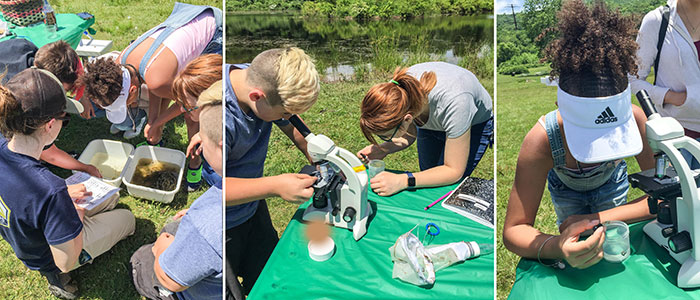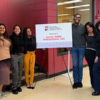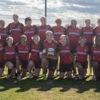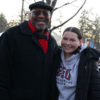ESU Faculty, Students Help Kids ‘Think Like a Scientist’

Posted by: Elizabeth Richardson on September 23, 2019, No Comments
Last spring, the organizers of “Science Sunday” witnessed a metamorphosis of sorts.
The program — a collaboration between the Delaware Water Gap National Recreation Area, East Stroudsburg University professors who are co-directors of the Pocono Writing Project, and Resica Elementary School in East Stroudsburg — was designed to get children and their families out into nature and teach them to think like scientists.
Over five Sundays, 19 Resica fourth-graders, their families and several teachers did such activities as examining plankton in pond water, dissolving limestone with chemicals and hiking in bucolic settings like Dingmans Falls and Kittatinny Point. Then the kids would write about the experiences.
In the course of those Sundays, Beth Rajan Sockman, Ph.D., professor of professional & secondary education, and Laura Kieselbach, Ed.D., assistant professor of English, saw transformations in the children as they learned to embrace nature, to think like scientists and gain confidence in their writing. But the professors saw changes in the parents as well.
Dr. Kieselbach recalls one mom who at the start of the program asked if she could wait in her car while her son did the activities. Kieselbach and others explained that the aim was for parents to explore nature with their kids. In no time, the mom was hiking with her son and coming back for more each Science Sunday.
“To see her out there enjoying the experience with him, that was one of the greatest outcomes that we experienced, an outcome that was really immeasurable,” Kieselbach said.
Another popular activity was investigating pond water for plankton and other tiny life forms. The kids looked through microscopes to find miniscule creatures in drops of water.
“The rangers talked about what the lifeforms were like, describing vertebrates and invertebrates,” Kieselbach said. For another activity, the students conducted a CSI-style investigation, looking at animal tracks in a sandbox to determine to what species they belonged.
Many of the hands-on lessons were created or modified by Jane Vandergeest, who interned with the Delaware Water Gap National Recreation Area before graduating from ESU last May. As a recreation management major, she generated activities for five or six stations for each Science Sunday.
“I had a station that showed how limestone dissolves in certain chemicals and the chemical reaction produces this kind of gas,” Vandergeest recalls. “The kids’ faces when they saw all the little bubbles forming on the rock…they were, ‘Oh, my gosh, look at what’s happening.’”
“It felt really good that I could see all this hard work come to life and be appreciated by children and families,” she said.
Another ESU student, Kyle Mackay, who is majoring in recreation and leisure service management, took over for Vandergeest when she graduated, gathering materials for each program, setting up stations and working with the kids. Doreen Lwanga, an elementary education major, also helped gather materials and write about the lessons, in addition to helping out at some Science Sundays.
Each Science Sunday lasted three hours but children and their families could come and go as they pleased, Dr. Sockman said. As the kids embraced nature and science, they also became more comfortable writing about it in spaces outside a classroom.
“There was definitely a substantial increase in people’s interest, not just being outside but also in writing,” Sockman said.
Science Sunday was funded by a grant from the Ganz Cooney Foundation, through the National Writing Project (of which the Pocono Writing Project is a branch) in coordination with the National Park Service. Sockman and Kieselbach co-wrote the grant and worked on the program with Jan Gebert, ESU instructor of professional and secondary education and a writing fellow with the National Writing Project.
Rainey McKenna, education outreach coordinator for the Delaware Water Gap National Recreation Area, was the point person for the park, working with Vandergeest in coming up with the activities and organizing each Sunday program. Many of the families hadn’t been to the chosen sites in the 70,000-acre park and they embraced the natural beauty and became enthusiastic hikers, she said.
“One of our goals was to introduce the students and their families to the resources that they had in their backyard,” McKenna said. “Most of the locations we introduced the families to they had never been to before. So one of the really neat things that came out of this is they discovered places that they want to return with their families.”
McKenna said the National Park Service and the National Writing Project regional office “considered our project highly successful and a model for other parks.”
She said the collaboration with ESU and Resica was beneficial all around and the park hopes to partner more with both, including providing additional opportunities for ESU’s pre-service teachers.
“So we’re building relationships to do even more …and look for ways to collaborate to connect our schools and our university and the park,” McKenna said.
Search
Recent Posts

Julianna and Wayne Bolt Art Contest Winners Selected for the 29th Annual Martin Luther King Jr. Celebration
December 10, 2025 - Read more

ESU Hosts 8th Annual Dr. Barbara G. Collins Social Work Professional Development Day
December 4, 2025 - Read more

ESU Professor Elected to American Society of Plant Biologists Steering Committee
November 25, 2025 - Read more

ESU Women’s Rugby Club Team Headed Back to Division III National Championships
November 25, 2025 - Read more
